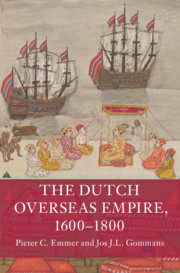Book contents
Introduction
Published online by Cambridge University Press: 29 September 2020
Summary
If we plot Dutch possessions on a map of the world from 1700, a quick glance would be enough to determine that in global terms the early modern Dutch overseas empire was very much a peripheral phenomenon. The Dutch had founded an immense empire that stretched like a string of pearls along the edges of the continents of Europe, Asia, America and Africa. The actual pearls consisted mostly of trading hubs, which were only partially conquered by the Dutch. Especially along the coasts of the powerful Asian empires such as Iran, India, China and Japan, and on the coast of West Africa, the Dutch had only small trading offices with no territorial rights. The Dutch Empire was therefore primarily a maritime phenomenon, with only a few ‘real’ colonies in the Caribbean, the Cape, on Java, the Moluccas, Ceylon and, for a short time, also in North America, Brazil and Taiwan. The Dutch Republic itself was also a rather marginal, maritime European phenomenon. After a long eighty-year revolt, the Rhine and Maas delta had formally shrugged off the grip of a continental European empire.
- Type
- Chapter
- Information
- The Dutch Overseas Empire, 1600–1800 , pp. 1 - 8Publisher: Cambridge University PressPrint publication year: 2020

